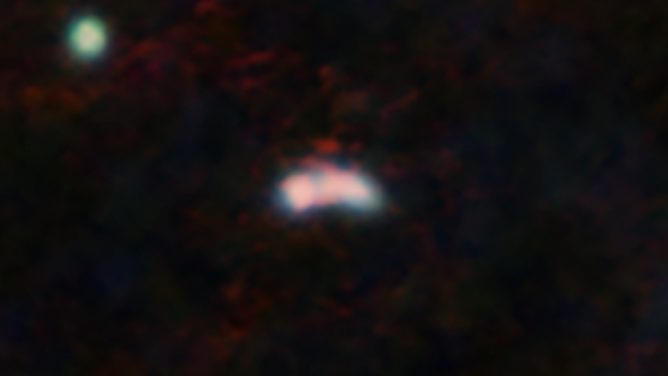2023.07.04
Baby Star Growing Fast through A 3-Layer Pancake-like Protostellar Disk
youngest disks, unveiling the very initial structure of the disk and a spiral arm in the midplane, allowing us to constrain the disk formation and accretion process in the earliest phase of star formation.

Figure1. The ALMA Map and Model of the HH 211 Protostellar Disk: (a) The map of the disk obtained by ALMA in dust emission. A Solar System size scale is added for the size comparison. (b) A highpass filter was applied to remove the smooth structure of the disk, in order to reveal the 3 linear structures (as marked by 3 dotted lines) perpendicular to the disk axis. (c) A disk model that can reproduce the disk structure. The left and right linear structures can be reproduced by the two warm disk surfaces, while the middle one is produced by the warm spiral arm in the midplane. (d) A face-on view of the disk model to show the full structure of the spiral arms. The spiral arms are trailing with their outer tip pointing in the direction opposite to the disk rotation. Credit: Lee et al.
The disk is located at the center of the HH 211 protostellar system, lying in Perseus at about 1000 light-year away. This system is very young, starting with a gravitational collapse only ~ 35000 yrs ago. Figure 1a shows our ALMA map of the disk in dust emission. As can be seen, the disk is very small with a radius similar to the orbital radius of Uranus in our Solar System. It is geometrically thick, indicating that the dust grains have yet to settle to the midplane, a step necessary for planet formation. Intriguingly, the disk shows 3 bright linear structures parallel to the equatorial plane (Figure 1b), resembling a 3-layer pancake that has not been seen before. Since these linear structures are on top of a smooth disk structure, a high-pass filter was applied on the ALMA map to reveal them more clearly in the figure. The left and right ones arise from the warm disk surfaces, unveiling the flared structure of the disk, as seen in our model shown in Figure 1c. More importantly, the middle one, which is in the dense midplane of the disk and asymmetric about the disk axis (i.e., with different lengths on the opposite sides of the disk axis), can be modeled as a trailing spiral arm excited by disk gravity (Figure 1c and Figure 1d for a face-on view of the model). Since spiral arms have been previously detected in more evolved protostellar disks, our results support the common presence of spiral arms in protostellar disks to transport the disk material inward toward the central protostars, facilitating the accretion process.
“We are so excited to have detected and resolved the young HH 211 disk, unveiling the early structure of the protostellar disk. Our detection of a spiral arm in the disk midplane also has an important implication to the accretion process because spiral arms have been predicted to transport the disk material inward toward the central protostars,” commented Chin-Fei Lee, who is the leading author of this work. “The observed spiral appears clumpy and may start to form planets.”
More Information:
The Atacama Large Millimeter/submillimeter Array (ALMA), an international astronomy facility, is a partnership of the European Organization for Astronomical Research in the Southern Hemisphere (ESO), the U.S. National Science Foundation (NSF) and the National Institutes of Natural Sciences (NINS) of Japan in cooperation with the Republic of Chile. ALMA is funded by ESO on behalf of its Member States, by NSF in cooperation with the National Research Council of Canada (NRC) and the National Science and Technology Council of Taiwan (NSTC), and by NINS in cooperation with the Academia Sinica (AS) in Taiwan and the Korea Astronomy and Space Science Institute (KASI).
ALMA construction and operations are led by ESO on behalf of its Member States; by the National Radio Astronomy Observatory (NRAO), managed by Associated Universities, Inc. (AUI), on behalf of North America; and by the National Astronomical Observatory of Japan (NAOJ) on behalf of East Asia. The Joint ALMA Observatory (JAO) provides the unified leadership and management of the construction, commissioning and operation of ALMA.
This research was presented in a paper “First Detection of A Linear Structure in the Midplane of the Young HH 211 Protostellar Disk: A Spiral Arm?” by Lee et al. appeared in Astrophysical Journal Letters(doi: 10.3847/2041-8213/acdbca.).
This article is based on the press release issued by Academia Sinica Institute of Astronomy and Astrophysics on July 4, 2023.
The team is composed of Chin-Fei Lee (ASIAA, Taiwan; National Taiwan University, Taiwan), Kai-Syun Jhan (ASIAA, Taiwan; National Taiwan University, Taiwan) and Anthony Moraghan (ASIAA, Taiwan)









